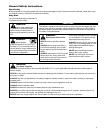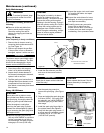
5
15
m
Be Aware of the Working Environment
Avoid long-term operation in
very hot or very cold weather.
Make sure bystanders or
observers outside the 15m
(50-foot) “danger zone” wear
Reduce the risk of
bystanders being struck
by ying debris. Make sure
no one is within 15 meters
(50 feet)—that’s about 16
paces—of an operating
blower.
15 METERS
Never operate the blower
if any component parts are
damaged, loose, or missing!
Debris sometimes collects on the
blower intake. Never clean out debris
from the blower while the engine is
running!
Be extremely careful of slippery
terrain, especially during rainy
weather. Never operate this
blower on a roof, ledge or ladder.
Be constantly alert
for objects and
debris that could be
thrown from the air
blast and bounced
from a hard surface.
Do not direct the air blast
towards bystanders. The
high air ow could blow
small objects at great
speed causing possible
eye injury.
Figure 2
An Emission Control Label is located on the unit. (This is an EXAMPLE ONLY; information on label varies by en-
gine FAMILY).
PRODUCT EMISSION DURABILITY
(EMISSION COMPLIANCE PERIOD)
The 300 hour emission compliance period is the time span selected by the manufacturer certifying the engine
emissions output meets applicable emissions regulations, provided that approved maintenance procedures are
followed as listed in the Maintenance Section of this manual.
Emission Control (Exhaust & Evaporative)
EPA 2010 and Later and/or C.A.R.B. TIER III
The emission control system for the engine is EM/TWC (Engine Modication and 3-way Catalyst) and for the
fuel tank the Control System is EVAP (Evaporative Emissions) or N (for nylon tank). Evaporative emission
may be applicable to California models only.


















